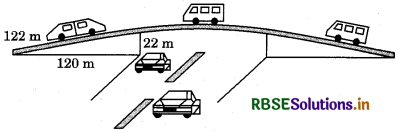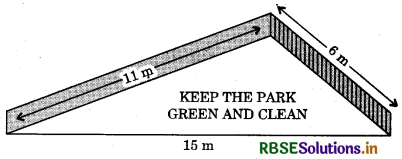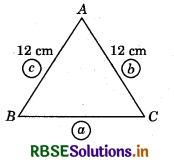RBSE Solutions for Class 9 Maths Chapter 12 Heron’s Formula Ex 12.1
Rajasthan Board RBSE Solutions for Class 9 Maths Chapter 12 Heron’s Formula Ex 12.1 Textbook Exercise Questions and Answers.
Rajasthan Board RBSE Solutions for Class 9 Maths in Hindi Medium & English Medium are part of RBSE Solutions for Class 9. Students can also read RBSE Class 9 Maths Important Questions for exam preparation. Students can also go through RBSE Class 9 Maths Notes to understand and remember the concepts easily. Practicing the class 9 math chapter 13 hindi medium textbook questions will help students analyse their level of preparation.
RBSE Class 9 Maths Solutions Chapter 12 Heron’s Formula Exercise 12.1
Question 1.
A traffic signal board, indicating ‘SCHOOL AHEAD’, is an equilateral triangle with side ‘a’. Find the area of the signal hoard, using Heron’s formula. If its perimeter is 180 cm, what will be the area of the signal board?
Answer:
To find the area of an equilateral triangle using Heron’s formula :
If a, b, c be the lengths of sides BC, CA and AB of ∆ABC and if s = \(\frac{1}{2}\)(a + b + c), then
Area of ∆ABC = \(\sqrt{s(s-a)(s-b)(s-c)}\)
Since, ∆ABC is given as an equilateral of side a, therefore
here, a = b = c (= a) and s = \(\frac{1}{2}\)(a + a + a) = \(\frac{3 a}{2}\)
Now, s - a = \(\frac{3 a}{2}\) - a = \(\frac{a}{2}\)
s - b = \(\frac{3 a}{2}\) - a = \(\frac{a}{2}\)
and s - c = \(\frac{3 a}{2}\) - a = \(\frac{a}{2}\)
∴ Area = \(\sqrt{\frac{3 a}{2} \times \frac{a}{2} \times \frac{a}{2} \times \frac{a}{2}}=\frac{a}{2} \times \frac{a}{2} \sqrt{3}=\frac{\sqrt{3} a^{2}}{4}\) .............. (1)
To find the area, when its perimeter = 180 cm, we have:
a + a + a = 180 cm ⇒ 3a = 180 cm
So, a = 60 cm
∴ Required area = \(\frac{\sqrt{3}}{4}\) × (60)2 cm2 [On putting a = 60 cm in (1)]
= 90073 cm2.

Question 2.
The triangular side walls of a flyover have been used for advertisements. The sides of the walls are 122 m, 22 m and 120 m (see figure). The advertisements yield an earning of ₹ 5000 per m2 per year. A company hired one of its walls for 3 months. How much rent did it pay?

Answer:
First we find the area of triangular side wall measuring 122 m, 22 m and 120 m.
Let a = 122 m, b = 22 m and c = 120 m.
s = \(\frac{1}{2}\)(a + b + c) = \(\frac{1}{2}\)(122 + 22 + 120) m = (\(\frac{1}{2}\) × 264)m = 132 mNow, s - a = (132 - 122) m = 10 m
Now, s - a = (132 - 122) m = 10 m
s - b = (132 - 22) m = 110 m and
s - c = (132 - 120) m = 12 m
∴ Area of triangular wall = \(\sqrt{s(s-a)(s-b)(s-c)}\)
= \(\sqrt{132 \times 10 \times 110 \times 12} \mathrm{~m}^{2}\)
= \(\sqrt{11 \times 12 \times 10 \times 10 \times 11 \times 12} \mathrm{~m}^{2}\)
= \(\sqrt{10 \times 10 \times 11 \times 11 \times 12 \times 12} \mathrm{~m}^{2}\)
= (10 × 11 × 12) m2 = 1320 m2
Aliter: (For finding the area of triangle)
We have: 1222 = 1202 + 222
∴ The walls area in the form of right triangles
∴ Area of the wall = \(\frac{1}{2}\) × base × height = \(\frac{1}{2}\) × 120 × 22 m2 <= 1320 m2.
Rent charges = ₹ 5000 per m2 per year
∴ Rent charged from a company for 3 months = ^(5000 × 1320 × \(\frac{3}{12}\))
= ₹ 1650000.
Question 3.
There is a slide in a park. One of its side walls has been painted in some colour with a message “KEEP THE PARK GREEN AND CLEAN” (see figure). If the sides of the wall are 15 m, 11 m and 6 m, find the area painted in colour.

Answer:
First find the area of side wall measuring 15 m, 11 m and 6 m.
Let a = 15 m, b = 11 m and c = 6 m.
So, s = \(\frac{1}{2}\) (a + b + c) = \(\frac{1}{2}\) (15 + 11 + 6) m = (\(\frac{1}{2}\) × 32) m = 16 m
Now, s - a = (16 - 15) m = 1 m
s - b = (16 - 11) m = 5 m
and s - c = (16 - 6) m = 10 m
∴ Area of side wall = \(\sqrt{s(s-a)(s-b)(s-c)}\)
= \(\sqrt{16 \times 1 \times 5 \times 10} \mathrm{~m}^{2}\)
= \(\sqrt{4 \times 4 \times 5 \times 5 \times 2}\) m2
= 4 × 5√2 m2 = 20√2 m2
Area painted in colour = Area of side wall = 20√2 m2.

Question 4.
Find the area of a triangle two sides of which are 18 cm and 10 cm and the perimeter is 42 cm.
Answer:
Let a, b and c be the sides of a triangle such that a = 18 cm, b = 10 cm and a + b + c = 42 cm.
∴ c = 42 - a - b
⇒ c = (42 - 18 - 10) cm = 14 cm
Now, s = \(\frac{1}{2}\) (a + b + c) = \(\frac{1}{2}\) × 42 cm = 21 cm
s - a = (21 - 18) m = 3 m
s - b = (21 - 10) m = 11 m
and s - c = (21 - 14) m = 7 m
∴ Area of the triangle = \(\sqrt{s(s-a)(s-b)(s-c)}\)
= \(\sqrt{21 \times 3 \times 11 \times 7}\) cm2
= \(\sqrt{3 \times 7 \times 3 \times 11 \times 7}\) cm2
= \(\sqrt{3 \times 3 \times 7 \times 7 \times 11}\) cm2
= 3 × 7 √11 cm2
= 21 √11 cm2
Question 5.
Sides of a triangle are in the ratio of 12 :17 : 25 and its perimeter is 540 cm. Find its area.
Answer:
Let the sides of the triangle be a, b and c.
a : b : c = 12 : 17 : 25
So, \(\frac{a}{12}=\frac{b}{17}=\frac{c}{25}\) = k (say)
∴ a = 12k, b = 17k and c = 25k
Also, perimeter = 540 1 cm
So, a + b + c = 540 ⇒ 12ft + 17ft + 25ft = 540
or 54k = 540, i.e. k = 10
Thus, a = 12 × 10 cm = 120 cm, b = 17 × 10 cm = 170 and c = 25 × 10 cm = 250 cm.
Now, s = \(\frac{1}{2}\) × 540 cm = 270 cm
s - a = (270 - 120) cm = 150 cm
s - b = (270 - 170) cm = 100 cm
and s - c = (270 - 250) cm = 20 cm
Now, Area of the triangle = \(\sqrt{s(s-a)(s-b)(s-c)}\)
= \(\sqrt{270 \times 150 \times 100 \times 20}\) cm2
= 100\(\sqrt{27 \times 15 \times 10 \times 2}\) cm2
= 100\(\sqrt{3 \times 3 \times 3 \times 3 \times 5 \times 5 \times 2 \times 2}\) cm2
= 100 × 3 × 3 × 5 × 2 cm2
= 9000 cm

Question 6.
An isosceles triangle has perimeter 30 cm and each of the equal sides is 12 cm. Find the area of the triangle. A
Answer:

Here c = b = 12 cm and a + b + c = perimeter = 30 cm
So, a = (30 - c - b) cm
or a = (30- 12 - 12) cm = 6 cm
Now s = \(\frac{1}{2}\) × 30 cm = 15 cm
s - a = (15 - 6) cm = 9 cm
s - b = (15 - 12) cm = 3 cm
and s - c = (15 - 12) cm = 3 cm
∴ Area of the triangle = \(\sqrt{s(s-a)(s-b)(s-c)}\)
= \(\sqrt{15 \times 9 \times 3 \times 3}\) cm2
= \(\sqrt{5 \times 3 \times 3 \times 3 \times 3 \times 3}\) cm2
= 3 × 3√5 × 3 cm2
= 9√15 cm2

- RBSE Solutions for Class 9 Maths Chapter 6 रेखाएँ और कोण Ex 6.3
- RBSE Solutions for Class 9 Maths Chapter 14 सांख्यिकीEx 14.3
- RBSE Solutions for Class 9 Maths Chapter 13 पृष्ठीय क्षेत्रफल एवं आयतन Ex 13.5
- RBSE Solutions for Class 9 Maths Chapter 13 पृष्ठीय क्षेत्रफल एवं आयतन Ex 13.4
- RBSE Solutions for Class 9 Maths Chapter 10 Circles Ex 10.3
- RBSE Solutions for Class 9 Maths Chapter 10 Circles Ex 10.2
- RBSE Solutions for Class 9 Maths Chapter 10 Circles Ex 10.1
- RBSE Solutions for Class 9 Maths Chapter 9 Areas of Parallelograms and Triangles Ex 9.2
- RBSE Solutions for Class 9 Maths Chapter 11 Constructions Ex 11.1
- RBSE Solutions for Class 9 Maths Chapter 9 Areas of Parallelograms and Triangles Ex 9.3
- RBSE Solutions for Class 9 Maths Chapter 11 Constructions Ex 11.2